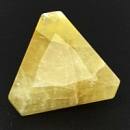|
|
||||||||||||||||
|
||||||||||||||||
|
||||||
|
|
|
|
Eitelite
|
|
| | |
| Discovered in 1954; IMA status: Valid (pre-IMA; Grandfathered) | ||
|
| ||
|
Chemistry |
|
|
| |
|
Na2Mg(CO3)2 | |
|
|
Sodium Magnesium Carbonate |
|
Molecular Weight: |
190.30 gm |
|
Composition: |
Sodium |
24.16 % |
Na |
32.57 % |
Na2O |
|
|
Magnesium |
12.77 % |
Mg |
21.18 % |
MgO |
|
|
Carbon |
12.62 % |
C |
46.25 % |
CO2 |
|
|
Oxygen |
50.44 % |
O |
|
|
|
|
|
100.00 % |
|
100.00 % |
= TOTAL OXIDE |
|
|
|
||||
|
Classification |
|
|
| |
|
Carbonates (Nitrates) | |
|
5/B.05-10 | |
|
|
5 : CARBONATES (NITRATES)
|
|
Related to: |
None |
|
Varieties: |
None |
|
Synonyms: |
ICSD 100482, PDF 24-1227 |
|
|
|
|
Crystal Data |
|
|
|
|
|
As imperfect rhombohedral to pseudo-octahedral crystals, to 17 mm, composed of {1011}, {0112} and {0001}. |
|
|
None |
|
|
|
|
|
Physical Properties |
|
|
|
|
|
Excellent on {0001}; and another transverse to {0001}, conspicuous |
|
|
Irregular/Uneven Conchoidal Fibrous Hackly Micaceous None observed Splintery Step-like Sub-Conchoidal |
|
|
Brittle |
|
|
3.5 |
|
|
2.737 (g/cm3) |
|
|
None |
|
|
Not Radioactive |
|
|
|
|
|
Optical Properties |
|
|
|
|
|
Colorless, pale yellow to staw yellow |
|
|
Transparent to translucent |
|
|
Vitreous |
|
|
1.450 - 1.605 Uniaxial ( - ) |
|
|
0.155 |
|
|
n/a |
|
|
None |
|
|
|
|
|
Occurances |
|
|
|
|
|
Geological Setting: |
An authigenic mineral in dolomitic shale and bituminous marlstone (Utah, USA); from an alkaline igneous pluton (Khibiny massif, Russia). |
|
Common Associations: |
Reedmergnerite, Leucosphenite, Searlesite, Crocidolite, Shortite (Kermit Poulson No. 1 well, Utah, USA); Trona, Nahcolite, Shortite, Northupite (Mapco Shrine Hospital #1 well, Utah, USA). |
|
Common Impurities: |
n/a |
|
Type Locality: |
Carter Oil Company Kermit Poulson No. 1 Well, Duchesne County, Utah, USA |
|
Year Discovered: |
1954 |
|
View mineral photos: | |
|
|
|
|
More Information |
|
|
|
|
|
| |
|
|
|
|
Sodium magnesium carbonate (Eitelite) had been known from laboratory experiments long before it was found as a natural mineral. In 1851 De Sainte-Claire Deville found that the anhydrous double carbonate formed when heating a concentrated solution of sodium carbonate with magnesium bicarbonate to boiling point. Natural Eitelite was first discovered in 1954 in a core sample from about 2,800 feet deep in the Carter Oil Company Kermit Poulson No. 1 Well, Duchesne County, Utah, USA and first analysed and described in 1955 by Charles Milton, J. M. Axelrod and F. S. Grimaldi. It was found in association with minerals such as Crocidolite, Searlesite and Shortite. Coincidentally, Shortite is another carbonate mineral that was also discovered in a well core sample. Eitelite was named to honor Dr. Wilhelm Hermann Julius Eitel (1891–1979), founder and Director of the Institute of Silicate Research, University of Toledo, Toledo, Ohio, USA, who first synthesized the compound. German born Eitel was among about 1,500 leading German scientists brought to the United States after World War II in Operation Paperclip, a postwar organization of scientific consultants whose task was to bring German scientists to America. He served as a consultant and research scientist for the U. S. Navy, and came to the University of Toledo in 1952 to establish the Institute of Silicate Research. The Institute has been renamed "The Eitel Institute for Silicate Research" in honor of the director emeritus. Dr. Eitel, who was proficient in twelve languages, was the author of numerous scientific articles and books. He had just completed volume 8 of his monograph series "Physical Chemistry of Silicates", when he died. Eitelite
distribution: in
the USA, in Utah, from drill core in the Green River
Formation, in Duchesne County, at the Kermit Poulson
No. 1 well and abundant in large crystals in the Mapco
Shrine Hospital #1 well; in the South Ouray well, Uintah
County. In Canada at the Ekati Mine, Lac de Gras, Northwest Territories.
From the Vuonnemiok River Valley, Khibiny massif, Kola
Peninsula, Russia. From Mahla Crater, Meidob Hills, South Darfur Wilayah, Sudan.
At the Darai-Pioz Glacier, Alai Range, Tien Shan Mtn, Region of Republican Subordination, Tajikistan.
|
|
|
We
have not photographed our Eitelite
gems yet. Please
check back soon. |
